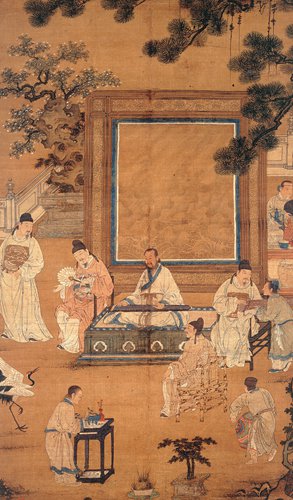
A copy of a traditional Chinese painting of the Ming Dynasty that is displayed in the Musée Cernuschi in Paris (Photo/Courtesy of Musée Cernuschi)
When visiting the Musée Cernuschi in Paris, guests can enjoy the scents of ancient Chinese perfumes of different dynasties recreated with original recipes.
Since March 9, the Shanghai Museum and the Musée Cernuschi have been jointly hosting the "Perfumes of China: The culture of incense in imperial times" exhibition, which will run until August 26, to showcase 110 art and archaeological objects, from fragrance burners to incense tables.
Furthermore, the exhibition provides visitors with the opportunity to participate in olfactory experiments facilitated by Francois Demachy, Christian Dior's perfumer.
"I found that the exhibition is quite pioneering. It gives you not only a visual banquet, but also a unique smelling experience," Sophie Bourguignon, a local French visitor, told the Global Times.
"The culture of incense played a major role in Chinese civilization," Eric Lefebvre, director of the Musée Cernuschi, the exhibition's curator, told the Global Times, adding that the showcase was inspired by the current public interest in traditional Chinese incense.
A few years ago, during a trip to China, Lefebvre realized that many people were becoming increasingly interested in ancient Chinese incense culture, including burning incense and collecting objects and documents related to incense.
"This aspect of contemporary Chinese social life struck me," Lefebvre said.
Fragrances are a new aspect of the traditional museum, which historically has been dominated by visual culture. "It was also a way to introduce a new exhibition model, not only by focusing on paintings, bronzes or ceramics, but including different kinds of objects linked to the incense culture of Imperial China," he added.
The exhibition guides visitors on a journey of exploration toward the history of incense and perfume in China from the 3rd century BC to the 19th century.
'Silk Road is Incense Road'
China has had a rich incense culture since the early Neolithic times, and later incense was used in a wide range of cultural activities including religious ceremonies and intellectual and literary life, permeating the development of Chinese civilization.
During the Han Dynasty (206 BC-AD 220), exotic and precious incense ingredients and spices began to enter the hinterland of China through the ancient Silk Road.
The term "Silk Road" was first coined by German geographer Ferdinand von Richthofen in 1877 as the collective name given to the network of trade routes linking China to Central and West Asia, the Mediterranean as well as India. The road was named after silk because silk at the time was the most common item exported from China, among other goods such as porcelain and tea.
The Silk Road also transmitted a wide range of imports from exotic cultures to China. Among them, incense and spices were the major goods.
"In this sense, the Silk Road is also the 'Incense Road' and 'Spice Road' from the Chinese perspective," Xiao Lei, deputy secretary-general of the Beijing Association for the Promotion of Incense Culture, told the Global Times.
Referred to as "Xiang" in Chinese, the word literally means "fragrance," but also carries a wider meaning of "incense, aroma, perfume and spices," referring to a broad group of scented substances that came in different forms.
During the Tang (AD 618-907) and Song (AD 960-1279) dynasties, personal fragrances had an important part to play when nobles entered scent contests. Burning incense soon became a highly artistic act, later providing inspiration for many artists, writers and musicians.
The trade of incense and spices also had a great influence on the rise and fall of the countries along the Silk Road, where trade in silk, porcelain and spices flourished, according to Xiao.
Culture restoration
Chinese incense culture gradually faded after the Tang and Song dynasties. By the start of modern age, the inheritance of the rich Chinese incense culture had almost become extinct.
However, by the late 1970s, when China began its economic reform policy and opening-up, the country's incense culture gradually became valued by Chinese people again.
Many advocates of Chinese incense culture initially followed "the Japanese Way of Incense," which was actually introduced to Japan by Buddhist monks from China. And in recent years, efforts have been made to restore traditional Chinese incense culture.
On May 21, 2015, Shennong, the Emperor of the Five Grains, who taught ancient China about the practices of agriculture some 5,000 years ago, became officially regarded as "the father of Chinese incense culture" during an academic conference held at Peking University. May 21 was thus officially set as the Memorial Day for Shennong.
One limited-edition copy of the Portrait of Shennong, which was once carried by the Shenzhou-11 spacecraft, was presented as a gift to the Needham Research Institute in Cambridge in the UK earlier this year. A lecture at the research institute about traditional Chinese incense culture was subsequently held to discover its significance to the ancient Silk Road.
Xiao said that the restoration of traditional Chinese incense culture is still in its infancy, however, adding that the art of Chinese incense is also about preserving Chinese culture and way of life and that incense is often paired with tea ceremonies, guqin zither performances, calligraphy and Chinese paintings.
"It is possible nowadays to compare the use of incense and spices in different cultures and different periods, thus we can better understand, further inherit and carry forward traditional Chinese incense culture," he said.
By cooperating with the Shanghai Museum, the unprecedented exhibition in Paris at the Musée Cernuschi has introduced Chinese incense culture to a more broad and international audience and revived the epitome of Chinese civilization.


















































